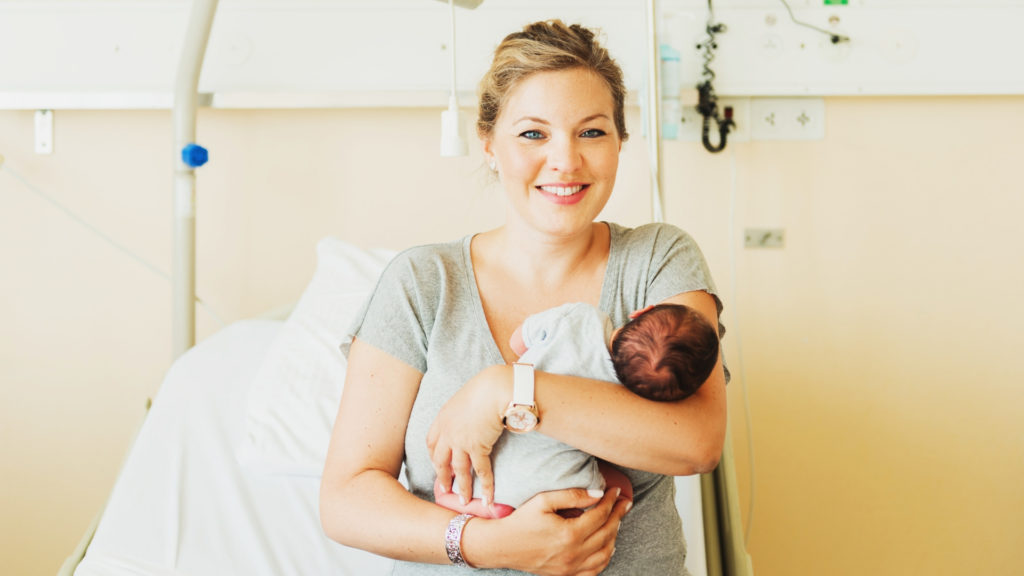As a new mom, no matter how many questions you ask or books you read, there’s really nothing that compares to the actual experience of recovering from birth. If you have a close group of friends that are moms, they are probably the best people that can give you the unfiltered version of a labor and recovery experience. Think of us as your close friends, sharing a couple of tidbits that aren’t talked about (as much) in the doctor’s office prior to labor.
Bleeding After Birth
Bleeding is expected after birth, but many new moms don’t realize just how much they will bleed and for how long. Right after birth, you will be given the dreaded “diaper” when your bleeding is the heaviest. It’s simply a large maxi pad wrapped in a pantyhose material for comfort.
You can expect to bleed for several weeks after birth, even if you’ve had a c-section. The first two weeks will be heavy, so thick maxi pads are best. Then you can switch to regular pads and then panty liners as your flow decreases.
Tip: When you pack your hospital bag, pack larger underwear that you don’t mind leaving behind.
Perineum Pain During Recovery
If you had a vaginal birth, your lady parts will be very sore and sensitive. Now when we say lady parts, we are talking about your perineum, which is the area between the vulva and anus. Now that we have that out of the way, here’s how to help you heal and ease the pain depending on your birth experience.
Recovery Time
For a vaginal birth without tears, you’ll likely feel discomfort in the area for around three to five weeks. If you experienced a vaginal tear or an episiotomy (a complete tear of the perineum area), it will take roughly seven to 10 days to heal. Expect to feel sore and sensitive for up to six weeks or more.
For moms who’ve had a C-section following labor, if you did push or get close to crowning, you may have some pain as well.
How to Help Ease Perenial Pain
Ice the perineum area to help with swelling after birth as many times as you need to. Your nurse should provide you with icepacks.
Warm water will also be your best friend. You will be given a small spray bottle you can fill with warm water to keep the area clean. Spritz before and after you use the restroom.
If you are able, warm spritz baths or a shallow bath soak can also make all the difference. This helps to ease pain and keeps you feeling clean. If you want to step it up a notch, try adding an essential oil such as lavender or tea tree oil. These oils have been known to contain anti-inflammatory, analgesic, and antiseptic properties.
There are some products you can use like soothing sprays such as lidocaine and Dermoplast. Both are available at major stores or pharmacies. If you had significant tearing, your doctor or nurse may just bring you some. Spray painful areas after you’re clean from the restroom.
Caring For Your C-Section Scar
Gently clean your C-section incision with soap and water once a day. Dry with a clean towel, then apply antibiotic ointment.
Hemorrhoids From Pushing
Yes – we’re going there. Hemorrhoids are very common after giving birth from pushing. Symptoms include pain, itching, bleeding after having a bowel movement, or a swollen area around the anus. Normally they go away on their own with time. Seek medical treatment if your hemmorids don’t go away after several weeks, or if you have uncontrollable bleeding in that area.
Going to the Bathroom
Going to the bathroom after your first time delivering a baby can be terrifying. Everything is so sore and tender, going number two is the last thing you want to do. However, it is so important that you stay regular. You don’t want to become constipated, this can make things worse.
Try eating fiber-rich foods and drink plenty of water to help ease things along. Your nurse may also ask you if you would like a gentle stool softener to avoid straining. The goal here is to make the experience as gentle as possible for your healing tissues.
Breast and Nipple Pain During Recovery
If you plan to breastfeed, your labor recovery may involve some breast and nipple discomfort. Both you and the baby are figuring out this whole breastfeeding thing together, and with that may come some cracked and sore nipples from latching. Either pack or ask your nurse to provide you with some lanolin cream to apply after each nursing session to help prevent damage.
Contractions After Birth
Contractions last even after birth, just when you thought you were done with them. These intense cramps can be felt for up to two weeks, but they typically aren’t as strong as labor contractions. These cramps are signals that your uterus is shrinking back down to its pre-pregnancy size.
Some moms even say they feel cramps worse when they are breastfeeding, as the hormone oxytocin is released during nipple stimulation. This hormone releases into your bloodstream and causes the contraction of all smooth muscles.
Although there are some not-so-glamorous things you must go through as a recovering mom , motherhood is such a beautiful thing. We hope this information helps give a better idea of what you can expect after delivery. We’re sure you have lots of questions after reading this, and that’s okay! We are here to help.

